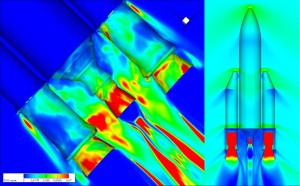Automotive
The FLuD group has ongoing collaborations with industry and international Universities to push forward the state of the art in modelling of fluid flow around generic cars. Recent projects have focussed on the flow physics of large scale separations at the rear of a car which substantially impact the overall drag, and computational aeroacoustics. This involves the application of new numerical methods and turbulence models to resolve the time dependent evolution of the base flow.
The video on the right shows results from the application of our recently developed fast computational aeroacoustics method, based on a new compressible Fractional Step Method. The geometry is the Ford DrivAer, at 16m/s. This research is in collaboration with Dr. S. Diasinos at Macquarie University.
The CFSM has been published here:
L Yu, S Diasinos, B Thornber, “A fast transient solver for low-Mach number aerodynamics and aeroacoustics“, Computers & Fluids 214, 10474, 2021
For more information, please contact: Assoc. Prof. Ben Thornber.
Air Wakes and Rotorcraft
Helicopter landings onto small platforms and ships are extremely challenging and dangerous. As a wind crosses over a ship it produces significant turbulent fluctuations which add greatly to pilot workload. Coupled with a severe mean flow, landing on a ship is one of the most dangerous scenarios a helicopter pilot can face. Research within the FLuD group aims to substantially improve the knowledge of the complex flows produced as a helicopter approaches to land, in collaboration with DSTG. This involves the development of helicopter blade models, and advanced unsteady turbulence modelling coupled with the high order accurate algorithms in our USyd and open source CFD packages.
We have recently proposed advanced unsteady Actuator Surface Models for rotorcraft problems which are fast and effective. We combined this with our Immersed Boundary Method to tackle challenging problems including interacting multiple Chinooks onboard a Navy vessel, the Mars helicopter Ingenuity and the DJI Phantom quadcopter.
Relevant publications may be found here:
D Linton, R Widjaja, B Thornber “Actuator Surface Model with Computational-Fluid-Dynamics-Convected Wake Model for Rotorcraft Applications”, AIAA Journal, 1-15, 2021
D Linton, R Widjaja, B Thornber, “Simulations of tandem and coaxial rotors using a CFD-coupled rotor model“, Australasian Fluid Mechanics Conference, 2018
S Chu, D Linton, D Verstraete, B Thornber, “Aerodynamic Analysis of Multi-Propeller/Wing Interaction using the Actuator Surface Model“, AIAA Scitech 2021 Forum, 1661, 2021.
HS Park, D Linton, B Thornber “Towards detached-eddy simulation of flow around rotorcraft using immersed boundary method” AIAA Journal 58 (11), 4893-4907, 2020
For more information, please contact: Assoc. Prof. Ben Thornber.
Wind Turbines and Wind Farms
The transition to an energy mix dominated by renewable sources is ramping up dramatically in order to mitigate further and more substantial impacts of climate change. Predictions by the IEA believe that by 2050, wind power will be responsible for the generation of one quarter to one third of the global electricity supply.
We are actively extending our methods developed for rotorcraft to individual and groups of wind turbines. These methods are substantially more accurate than existing actuator disc models, and faster than other unsteady methods such as actuator line and fully resolved.
The animation on the right shows recent results gained from a computation of the MEXICO turbine, in both nominal and yawed conditions. The numerical methods employed are the Actuator Surface Model for the blades, and Immersed Boundary Method for the nacelle and tower. With a modest cluster, each full rotation can be completed in just a couple of minutes.
For more information, please contact: Assoc. Prof. Ben Thornber or Dr. Daniel Linton.
High-speed Aero-acoustics
As a fluid passes over an open cavity it naturally produces noise, most commonly experienced when you open a car window. In aeronautical applications, a similar mechanism causes very high noise levels in wheel bays, optical bays, or weapons bays. These high levels of noise can be substantial enough to cause damage to structures and systems within the cavity. Research into multiple cavity configurations and applications is under way within the FLuD group together with industry partners, with an aim to improve understanding of more complex cavity shapes at a range of Mach and Reynolds numbers. A visualisation of a complex flow-acoustic interaction over a cavity at Mach 0.8 is shown.
For more information, please contact: Assoc. Prof. Ben Thornber.
Flow-acoustic interaction over a deep cavity at Mach 0.8
Aeronautical
Multiple aerodynamics applications are under active research within the group. This stems from traditional applied aerodynamic calculations of lift and drag using steady RANS methods, through to state of the art computations of high speed intakes, high lift configurations, launcher base flows and drag reduction methodologies in collaboration with industry partners. Results of an Implicit Large Eddy Simulation of the Ariane 5 base flow is shown.
For more information, please contact: Assoc. Prof. Ben Thornber.
